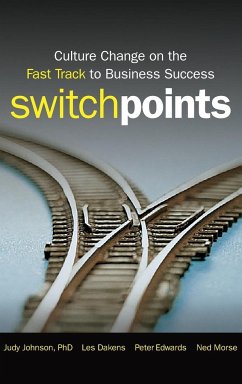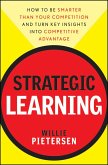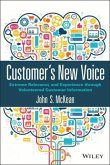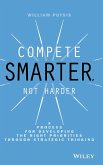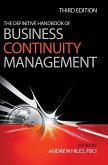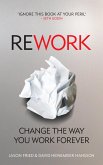Judy Johnson, Les Dakens, Peter Edwards, Ned MorseCulture Change on the Fast Track to Business Success
Switchpoints
Culture Change on the Fast Track to Business Success
Mitarbeit: Johnson, Judy; Dakens, Les; Edwards, Peter
Judy Johnson, Les Dakens, Peter Edwards, Ned MorseCulture Change on the Fast Track to Business Success
Switchpoints
Culture Change on the Fast Track to Business Success
Mitarbeit: Johnson, Judy; Dakens, Les; Edwards, Peter
- Gebundenes Buch
- Merkliste
- Auf die Merkliste
- Bewerten Bewerten
- Teilen
- Produkt teilen
- Produkterinnerung
- Produkterinnerung
Over the past four years, Canadian Nation Railway has risen to the top of North American railroads, becoming a favourite among customers and investors alike. S witchPoints tracks the way in which a "top down" culture change turned the business around and offers a series of takeaway methods as for leaders to apply in their own organisations.
Praise for SwitchPoints
"SwitchPoints is great reading for anyone in a leadership role. The lessons on theimportance of culture are clear and transferable. I highly recommend this book." --William R. Johnson, Chairman, President, and CEO, H.J. Heinz…mehr
Andere Kunden interessierten sich auch für
![The Dream Cafe The Dream Cafe]() Duncan BruceThe Dream Cafe26,99 €
Duncan BruceThe Dream Cafe26,99 €![Strategic Learning Strategic Learning]() Willie PietersenStrategic Learning28,99 €
Willie PietersenStrategic Learning28,99 €![Customer's New Voice Customer's New Voice]() John S. McKeanCustomer's New Voice40,99 €
John S. McKeanCustomer's New Voice40,99 €![Trust Trust]() Rita Cruise O'BrienTrust99,99 €
Rita Cruise O'BrienTrust99,99 €![Compete Smarter, Not Harder Compete Smarter, Not Harder]() William PutsisCompete Smarter, Not Harder21,99 €
William PutsisCompete Smarter, Not Harder21,99 €![Definitive Handbook of Busines Definitive Handbook of Busines]() Andrew HilesDefinitive Handbook of Busines76,99 €
Andrew HilesDefinitive Handbook of Busines76,99 €![ReWork ReWork]() Jason FriedReWork14,39 €
Jason FriedReWork14,39 €-
-
-
Over the past four years, Canadian Nation Railway has risen to the top of North American railroads, becoming a favourite among customers and investors alike. S witchPoints tracks the way in which a "top down" culture change turned the business around and offers a series of takeaway methods as for leaders to apply in their own organisations.
Praise for SwitchPoints
"SwitchPoints is great reading for anyone in a leadership role. The lessons on theimportance of culture are clear and transferable. I highly recommend this book." --William R. Johnson, Chairman, President, and CEO, H.J. Heinz Company
"Any successful service business is the result of both sound management and good leadership--qualities epitomized by Hunter Harrison and the team that transformed CN from an economic laggard to the leader in its field." --Frederick W. Smith, Chairman and CEO, FedEx Corporation
"SwitchPoints is a fascinating account of how the proper use of resources and technologies can be beneficial to everyone, including workers. The sweeping changes at CN Rail were awkward and difficult to accept at first, but have influenced the renewal of rail transport across the continent." --Buzz Hargrove, National President, Canadian Auto Workers
"SwitchPoints is a powerful blueprint for transformational change for any leader who faces seemingly insurmountable organizational challenges, including the one to either perish or persist." --John Dineen, President and CEO, GE - Transportation
"The transformation of Canadian National Railway from industry laggard to industry leader is a remarkable story. SwitchPoints offers a fascinating look at how Hunter Harrison led the CN team to accomplish that transformation." --Wick Moorman, CEO, Norfolk Southern Corporation
Hinweis: Dieser Artikel kann nur an eine deutsche Lieferadresse ausgeliefert werden.
Praise for SwitchPoints
"SwitchPoints is great reading for anyone in a leadership role. The lessons on theimportance of culture are clear and transferable. I highly recommend this book." --William R. Johnson, Chairman, President, and CEO, H.J. Heinz Company
"Any successful service business is the result of both sound management and good leadership--qualities epitomized by Hunter Harrison and the team that transformed CN from an economic laggard to the leader in its field." --Frederick W. Smith, Chairman and CEO, FedEx Corporation
"SwitchPoints is a fascinating account of how the proper use of resources and technologies can be beneficial to everyone, including workers. The sweeping changes at CN Rail were awkward and difficult to accept at first, but have influenced the renewal of rail transport across the continent." --Buzz Hargrove, National President, Canadian Auto Workers
"SwitchPoints is a powerful blueprint for transformational change for any leader who faces seemingly insurmountable organizational challenges, including the one to either perish or persist." --John Dineen, President and CEO, GE - Transportation
"The transformation of Canadian National Railway from industry laggard to industry leader is a remarkable story. SwitchPoints offers a fascinating look at how Hunter Harrison led the CN team to accomplish that transformation." --Wick Moorman, CEO, Norfolk Southern Corporation
Hinweis: Dieser Artikel kann nur an eine deutsche Lieferadresse ausgeliefert werden.
Produktdetails
- Produktdetails
- Verlag: Wiley & Sons
- Artikelnr. des Verlages: 14528383000
- 1. Auflage
- Seitenzahl: 288
- Erscheinungstermin: 1. Oktober 2008
- Englisch
- Abmessung: 235mm x 157mm x 20mm
- Gewicht: 486g
- ISBN-13: 9780470283837
- ISBN-10: 0470283831
- Artikelnr.: 23819527
- Herstellerkennzeichnung
- Libri GmbH
- Europaallee 1
- 36244 Bad Hersfeld
- gpsr@libri.de
- Verlag: Wiley & Sons
- Artikelnr. des Verlages: 14528383000
- 1. Auflage
- Seitenzahl: 288
- Erscheinungstermin: 1. Oktober 2008
- Englisch
- Abmessung: 235mm x 157mm x 20mm
- Gewicht: 486g
- ISBN-13: 9780470283837
- ISBN-10: 0470283831
- Artikelnr.: 23819527
- Herstellerkennzeichnung
- Libri GmbH
- Europaallee 1
- 36244 Bad Hersfeld
- gpsr@libri.de
JUDY JOHNSON, PhD, a Partner with the Continuous Learning Group (CLG), applies behavioral science to help leaders create environments that dramatically improve organizational performance and profitability. Johnson coaches executives on personal leadership and executing strategies through pinpointing key behaviors that lead to success. LES DAKENS, retired Senior Vice President of People for CN, was responsible for strategic direction of CN's Human Resources and Labour Relations in North America and worldwide. Prior to joining CN, Dakens was Vice President of Human Resources for the North American division of the H.J. Heinz Company. PETER EDWARDS, Vice President of Human Resources for CN, is responsible for human resources, culture change, implementation, leadership, and organizational development. He assisted CN's CEO in writing two landmark books for employees. EDWARD (NED) MORSE, a Senior Partner with CLG, offers three decades of experience helping Fortune 500 executives develop and implement business-critical strategies. Morse has worked with clients in transportation, petrochemicals, food service, healthcare, engineering, telecommunications, insurance, pharmaceuticals, and retail.
List of Illustrations xvii
Foreword xix
Preface xxiii
Acknowledgments xxv
Introduction: A Broken Culture xxix
The Culture of Early Quits xxx
A New Trip Plan xxxi
Switchpoints xxxi
Spiking the Switch xxxiii
Part I Building One of North America's Top Railroads 1
Chapter 1 The Road to Best-in-Class 3
1830: Pioneering Days 3
1919: Nationalization 3
The 1980s: Deregulation 5
1992: Organizational Redesign 6
A Quick Change 7
1995: Privatization 8
The Right Leaders for the Job 9
1998: Precision Railroading 10
2003: Passing the Reins 13
Chapter 2 Culture Change on the Fast Track 15
Acquisitions 15
Buying Other Cultures 16
The Challenge 17
The Results 17
The Trip Plan for Culture Change on the Fast Track 18
Part II Clarifying the Vision 21
Chapter 3 CN's Five Guiding Principles 23
Chapter 4 The Culture of Precision Railroading 27
The Organizational Culture Continuum 28
The Spectrum of Employee Engagement 29
The Role of Organizational Leaders 30
Washing Out the Mud in the Middle 31
Part III Choosing the Right Switchpoints 35
Chapter 5 How to Change CN's Culture? 37
Culture Equals Behavior 37
Chapter 6 Creating a Culture of Discretionary PerformanceSM 40
What's in It for the Employee? 41
Chapter 7 Creating Q4 Leaders to Drive Change 43
Culture Change Begins with Leadership 43
The Q4 LeadershipSM Model 44
How Did CN Create Q4 Leaders? 46
Changing Your Style Isn't Easy 47
Building Leadership Fluency 49
Part IV Selecting the Tools for Change 51
Chapter 8 The Science of the ABCs 53
It's All about Behavior 53
The ABCs of Behavior 54
The ABCs Make Fundamental Sense 55
Chapter 9 The Commanding Power of Consequences 58
Timing 59
Importance to Recipient 59
Probability of Recurring 60
Where Does the Consequence Come From? 60
Which Consequences Should I Use? 62
Consequences and Culture Change 63
Authors' Note: Doing the Right Thing with the ABCs 63
Chapter 10 The ABC Toolkit 65
The Five-Step Model 65
Part V Aligning the Switches 73
Chapter 11 Finding a Champion 75
A Quiet Tryout in Capreol 75
"I Hate Consultants!" 77
Chapter 12 Testing the Business Case 81
Pilot 1: Partnering in Memphis 82
Pilot 2: Partnering in Capreol (Northern Ontario) 83
Pilot 3: Partnering in Transcona (Winnipeg) 84
Learnings from the Pilots 85
We Did What We Said We Would Do 86
A Skeptical Hunter Gives the Nod 87
Chapter 13 Gaining Visible Sponsorship: The CEO's Essential Role 89
"How We Work and Why" 89
Addressing the Naysayers 91
Chapter 14 Learning from a Strike 93
Spiking the Switch 94
Start with the Supervisors 95
Chapter 15 Planning the Trip 98
Going to Rome (and Paying for It) 98
Implementing the ABCs CN-Wide 99
Selling the ABCs to the Operating Regions 100
I Love Your Passion, But . . . 101
Managing the Pull 102
Deployment Wasn't All Rosy 103
Chapter 16 Making the Case for Change 105
The Case for the ABCs 105
Spreading the Word 107
Answering Four Basic Questions 108
Chapter 17 Expanding Sponsorship 110
Example 1: Visiting Sites to Set the Stage 110
Example 2: Sponsoring a Safety-First Culture 113
Example 3: Personally Walking the Talk 117
Part VI Assessing Switchpoints' Impact 121
Chapter 18 Applying the ABCs: Dressed & Ready 123
Guess I'll Have Another Coffee . . . 123
Another Switchpoint 124
The Science behind the Change 124
Of Course There Was Resistance! 128
"I Can't Ask My Friends to Do That!" 128
The Rewards of "Dressed & Ready" 130
Chapter 19 Early Wins with the ABCs 131
Release the Brakes! 131
Culture Change in the Michigan Division 133
The ABCs Improve ETAs 135
Want Better Meetings? Show Up on Time! 136
Small Things Matter 138
Curing Technophobia 140
Chapter 20 Demonstrating Q4 LeadershipSM
Through the ABCs 143
"More Work? Are You Nuts?!" 143
Improving Reliability: Getting KIST 145
Understanding Q4 LeadershipSM-by Knowing What It Is Not 147
Chapter 21 Life or Death Leadership 149
A Grim Tale 149
Safety and Culture Change 150
Developing Safety Programs 151
Zero Tolerance and Why 154
Chapter 22 Sawing Our Way to Improvement 157
Tackling Old Problems in New Ways 159
Reducing Overtime 159
"Improve" Can Even Mean Tossing Old Paper Files 162
Formalizing the Opportunity 163
Part VII Spiking the Switches 165
Chapter 23 Leadership Competencies to Support the Change 167
Accountability and Importance 168
The New Competency Framework 168
Leadership Equals Bonus 170
The New Power of Performance Reviews 171
Chapter 24 Performance Scorecards for Unionized Employees 173
Doing the Unthinkable 174
Executing EPS 175
Communicating EPS 175
Then Came the Problems 176
Rollout for Success 177
Supervisors: I Didn't Know That! 178
EPS Was Another Switchpoint 178
Chapter 25 Learning through the Railroad MBA 180
The Railroad MBA 180
Railroader Undergraduate Programs 181
CN Is a Destination, Not a Job 182
Today North America, Tomorrow the World 183
Chapter 26 Hunter Camps Develop Leaders 184
Expanding the Impact 185
Learning from the Master 185
Twelve Characteristics of Leadership 186
Leadership Is about People 187
Some Campers' Views 188
Chapter 27 The Power of Consistency (17 out of 17) 191
Inconsistency in the Rules 192
Inconsistency in Applying Rules 193
Inconsistency Breeds Opportunity 194
Be Consistently Flexible 195
Chapter 28 Developing Internal Consultants 197
Why Internal Consultants? 197
Transitioning from CLG to Internal CN Consultants 198
Selecting the Right People 199
Developing Internal Consultants 199
Reality Hits 200
The Value of Internal Consultants 202
Chapter 29 Sustaining Culture Change 204
Preventing Backsliding 204
Techniques for Sustaining Change 207
Examples of Sustainability 208
Chapter 30 Sharing Our Story 209
Sharing with Our Customers 210
Sharing with Our Suppliers 210
Sharing with Our Competitors 212
Sharing with Our Communities 213
Chapter 31 Improving Relations with Our Unions 216
The 2007 UTU Strike 216
When to Say Yes, When to Say No 218
Confronting a Long Legacy 218
The United Steelworkers 220
Improving Labor Relations 221
What CN Brings to the Bargaining Table 222
The Future 223
Part VIII Learning from Our Journey 225
Chapter 32 Top 10 Tips for Leaders Using theABC Methodology 227
Tip 1: Manage Your Culture 227
Tip 2: Measure What You Value 228
Tip 3: Challenge, Disagree, and Then Make the Decision 228
Tip 4: Focus on Behavior You See or Hear at Work 228
Tip 5: Ask "Would You, If Your Life Depended on It?" 228
Tip 6: Transition from Good to Great Performers 229
Tip 7: Deal Quickly with Poor Performers 229
Tip 8: Get Face-to-Face 229
Tip 9: Balance Your Use of Consequences 229
Tip 10: Manage the Learning Curve 230
Chapter 33 The Culture Change We Achieved 231
Ten Lessons Learned from Our Switchpoints 231
Chapter 34 The Final Word 234
The Transformation 234
What Lies Ahead 235
Where We Are Now 236
The Trip Is Not Over 237
Notes 241
About the Authors 243
About the Companies 247
Index 249
Foreword xix
Preface xxiii
Acknowledgments xxv
Introduction: A Broken Culture xxix
The Culture of Early Quits xxx
A New Trip Plan xxxi
Switchpoints xxxi
Spiking the Switch xxxiii
Part I Building One of North America's Top Railroads 1
Chapter 1 The Road to Best-in-Class 3
1830: Pioneering Days 3
1919: Nationalization 3
The 1980s: Deregulation 5
1992: Organizational Redesign 6
A Quick Change 7
1995: Privatization 8
The Right Leaders for the Job 9
1998: Precision Railroading 10
2003: Passing the Reins 13
Chapter 2 Culture Change on the Fast Track 15
Acquisitions 15
Buying Other Cultures 16
The Challenge 17
The Results 17
The Trip Plan for Culture Change on the Fast Track 18
Part II Clarifying the Vision 21
Chapter 3 CN's Five Guiding Principles 23
Chapter 4 The Culture of Precision Railroading 27
The Organizational Culture Continuum 28
The Spectrum of Employee Engagement 29
The Role of Organizational Leaders 30
Washing Out the Mud in the Middle 31
Part III Choosing the Right Switchpoints 35
Chapter 5 How to Change CN's Culture? 37
Culture Equals Behavior 37
Chapter 6 Creating a Culture of Discretionary PerformanceSM 40
What's in It for the Employee? 41
Chapter 7 Creating Q4 Leaders to Drive Change 43
Culture Change Begins with Leadership 43
The Q4 LeadershipSM Model 44
How Did CN Create Q4 Leaders? 46
Changing Your Style Isn't Easy 47
Building Leadership Fluency 49
Part IV Selecting the Tools for Change 51
Chapter 8 The Science of the ABCs 53
It's All about Behavior 53
The ABCs of Behavior 54
The ABCs Make Fundamental Sense 55
Chapter 9 The Commanding Power of Consequences 58
Timing 59
Importance to Recipient 59
Probability of Recurring 60
Where Does the Consequence Come From? 60
Which Consequences Should I Use? 62
Consequences and Culture Change 63
Authors' Note: Doing the Right Thing with the ABCs 63
Chapter 10 The ABC Toolkit 65
The Five-Step Model 65
Part V Aligning the Switches 73
Chapter 11 Finding a Champion 75
A Quiet Tryout in Capreol 75
"I Hate Consultants!" 77
Chapter 12 Testing the Business Case 81
Pilot 1: Partnering in Memphis 82
Pilot 2: Partnering in Capreol (Northern Ontario) 83
Pilot 3: Partnering in Transcona (Winnipeg) 84
Learnings from the Pilots 85
We Did What We Said We Would Do 86
A Skeptical Hunter Gives the Nod 87
Chapter 13 Gaining Visible Sponsorship: The CEO's Essential Role 89
"How We Work and Why" 89
Addressing the Naysayers 91
Chapter 14 Learning from a Strike 93
Spiking the Switch 94
Start with the Supervisors 95
Chapter 15 Planning the Trip 98
Going to Rome (and Paying for It) 98
Implementing the ABCs CN-Wide 99
Selling the ABCs to the Operating Regions 100
I Love Your Passion, But . . . 101
Managing the Pull 102
Deployment Wasn't All Rosy 103
Chapter 16 Making the Case for Change 105
The Case for the ABCs 105
Spreading the Word 107
Answering Four Basic Questions 108
Chapter 17 Expanding Sponsorship 110
Example 1: Visiting Sites to Set the Stage 110
Example 2: Sponsoring a Safety-First Culture 113
Example 3: Personally Walking the Talk 117
Part VI Assessing Switchpoints' Impact 121
Chapter 18 Applying the ABCs: Dressed & Ready 123
Guess I'll Have Another Coffee . . . 123
Another Switchpoint 124
The Science behind the Change 124
Of Course There Was Resistance! 128
"I Can't Ask My Friends to Do That!" 128
The Rewards of "Dressed & Ready" 130
Chapter 19 Early Wins with the ABCs 131
Release the Brakes! 131
Culture Change in the Michigan Division 133
The ABCs Improve ETAs 135
Want Better Meetings? Show Up on Time! 136
Small Things Matter 138
Curing Technophobia 140
Chapter 20 Demonstrating Q4 LeadershipSM
Through the ABCs 143
"More Work? Are You Nuts?!" 143
Improving Reliability: Getting KIST 145
Understanding Q4 LeadershipSM-by Knowing What It Is Not 147
Chapter 21 Life or Death Leadership 149
A Grim Tale 149
Safety and Culture Change 150
Developing Safety Programs 151
Zero Tolerance and Why 154
Chapter 22 Sawing Our Way to Improvement 157
Tackling Old Problems in New Ways 159
Reducing Overtime 159
"Improve" Can Even Mean Tossing Old Paper Files 162
Formalizing the Opportunity 163
Part VII Spiking the Switches 165
Chapter 23 Leadership Competencies to Support the Change 167
Accountability and Importance 168
The New Competency Framework 168
Leadership Equals Bonus 170
The New Power of Performance Reviews 171
Chapter 24 Performance Scorecards for Unionized Employees 173
Doing the Unthinkable 174
Executing EPS 175
Communicating EPS 175
Then Came the Problems 176
Rollout for Success 177
Supervisors: I Didn't Know That! 178
EPS Was Another Switchpoint 178
Chapter 25 Learning through the Railroad MBA 180
The Railroad MBA 180
Railroader Undergraduate Programs 181
CN Is a Destination, Not a Job 182
Today North America, Tomorrow the World 183
Chapter 26 Hunter Camps Develop Leaders 184
Expanding the Impact 185
Learning from the Master 185
Twelve Characteristics of Leadership 186
Leadership Is about People 187
Some Campers' Views 188
Chapter 27 The Power of Consistency (17 out of 17) 191
Inconsistency in the Rules 192
Inconsistency in Applying Rules 193
Inconsistency Breeds Opportunity 194
Be Consistently Flexible 195
Chapter 28 Developing Internal Consultants 197
Why Internal Consultants? 197
Transitioning from CLG to Internal CN Consultants 198
Selecting the Right People 199
Developing Internal Consultants 199
Reality Hits 200
The Value of Internal Consultants 202
Chapter 29 Sustaining Culture Change 204
Preventing Backsliding 204
Techniques for Sustaining Change 207
Examples of Sustainability 208
Chapter 30 Sharing Our Story 209
Sharing with Our Customers 210
Sharing with Our Suppliers 210
Sharing with Our Competitors 212
Sharing with Our Communities 213
Chapter 31 Improving Relations with Our Unions 216
The 2007 UTU Strike 216
When to Say Yes, When to Say No 218
Confronting a Long Legacy 218
The United Steelworkers 220
Improving Labor Relations 221
What CN Brings to the Bargaining Table 222
The Future 223
Part VIII Learning from Our Journey 225
Chapter 32 Top 10 Tips for Leaders Using theABC Methodology 227
Tip 1: Manage Your Culture 227
Tip 2: Measure What You Value 228
Tip 3: Challenge, Disagree, and Then Make the Decision 228
Tip 4: Focus on Behavior You See or Hear at Work 228
Tip 5: Ask "Would You, If Your Life Depended on It?" 228
Tip 6: Transition from Good to Great Performers 229
Tip 7: Deal Quickly with Poor Performers 229
Tip 8: Get Face-to-Face 229
Tip 9: Balance Your Use of Consequences 229
Tip 10: Manage the Learning Curve 230
Chapter 33 The Culture Change We Achieved 231
Ten Lessons Learned from Our Switchpoints 231
Chapter 34 The Final Word 234
The Transformation 234
What Lies Ahead 235
Where We Are Now 236
The Trip Is Not Over 237
Notes 241
About the Authors 243
About the Companies 247
Index 249
List of Illustrations xvii
Foreword xix
Preface xxiii
Acknowledgments xxv
Introduction: A Broken Culture xxix
The Culture of Early Quits xxx
A New Trip Plan xxxi
Switchpoints xxxi
Spiking the Switch xxxiii
Part I Building One of North America's Top Railroads 1
Chapter 1 The Road to Best-in-Class 3
1830: Pioneering Days 3
1919: Nationalization 3
The 1980s: Deregulation 5
1992: Organizational Redesign 6
A Quick Change 7
1995: Privatization 8
The Right Leaders for the Job 9
1998: Precision Railroading 10
2003: Passing the Reins 13
Chapter 2 Culture Change on the Fast Track 15
Acquisitions 15
Buying Other Cultures 16
The Challenge 17
The Results 17
The Trip Plan for Culture Change on the Fast Track 18
Part II Clarifying the Vision 21
Chapter 3 CN's Five Guiding Principles 23
Chapter 4 The Culture of Precision Railroading 27
The Organizational Culture Continuum 28
The Spectrum of Employee Engagement 29
The Role of Organizational Leaders 30
Washing Out the Mud in the Middle 31
Part III Choosing the Right Switchpoints 35
Chapter 5 How to Change CN's Culture? 37
Culture Equals Behavior 37
Chapter 6 Creating a Culture of Discretionary PerformanceSM 40
What's in It for the Employee? 41
Chapter 7 Creating Q4 Leaders to Drive Change 43
Culture Change Begins with Leadership 43
The Q4 LeadershipSM Model 44
How Did CN Create Q4 Leaders? 46
Changing Your Style Isn't Easy 47
Building Leadership Fluency 49
Part IV Selecting the Tools for Change 51
Chapter 8 The Science of the ABCs 53
It's All about Behavior 53
The ABCs of Behavior 54
The ABCs Make Fundamental Sense 55
Chapter 9 The Commanding Power of Consequences 58
Timing 59
Importance to Recipient 59
Probability of Recurring 60
Where Does the Consequence Come From? 60
Which Consequences Should I Use? 62
Consequences and Culture Change 63
Authors' Note: Doing the Right Thing with the ABCs 63
Chapter 10 The ABC Toolkit 65
The Five-Step Model 65
Part V Aligning the Switches 73
Chapter 11 Finding a Champion 75
A Quiet Tryout in Capreol 75
"I Hate Consultants!" 77
Chapter 12 Testing the Business Case 81
Pilot 1: Partnering in Memphis 82
Pilot 2: Partnering in Capreol (Northern Ontario) 83
Pilot 3: Partnering in Transcona (Winnipeg) 84
Learnings from the Pilots 85
We Did What We Said We Would Do 86
A Skeptical Hunter Gives the Nod 87
Chapter 13 Gaining Visible Sponsorship: The CEO's Essential Role 89
"How We Work and Why" 89
Addressing the Naysayers 91
Chapter 14 Learning from a Strike 93
Spiking the Switch 94
Start with the Supervisors 95
Chapter 15 Planning the Trip 98
Going to Rome (and Paying for It) 98
Implementing the ABCs CN-Wide 99
Selling the ABCs to the Operating Regions 100
I Love Your Passion, But . . . 101
Managing the Pull 102
Deployment Wasn't All Rosy 103
Chapter 16 Making the Case for Change 105
The Case for the ABCs 105
Spreading the Word 107
Answering Four Basic Questions 108
Chapter 17 Expanding Sponsorship 110
Example 1: Visiting Sites to Set the Stage 110
Example 2: Sponsoring a Safety-First Culture 113
Example 3: Personally Walking the Talk 117
Part VI Assessing Switchpoints' Impact 121
Chapter 18 Applying the ABCs: Dressed & Ready 123
Guess I'll Have Another Coffee . . . 123
Another Switchpoint 124
The Science behind the Change 124
Of Course There Was Resistance! 128
"I Can't Ask My Friends to Do That!" 128
The Rewards of "Dressed & Ready" 130
Chapter 19 Early Wins with the ABCs 131
Release the Brakes! 131
Culture Change in the Michigan Division 133
The ABCs Improve ETAs 135
Want Better Meetings? Show Up on Time! 136
Small Things Matter 138
Curing Technophobia 140
Chapter 20 Demonstrating Q4 LeadershipSM
Through the ABCs 143
"More Work? Are You Nuts?!" 143
Improving Reliability: Getting KIST 145
Understanding Q4 LeadershipSM-by Knowing What It Is Not 147
Chapter 21 Life or Death Leadership 149
A Grim Tale 149
Safety and Culture Change 150
Developing Safety Programs 151
Zero Tolerance and Why 154
Chapter 22 Sawing Our Way to Improvement 157
Tackling Old Problems in New Ways 159
Reducing Overtime 159
"Improve" Can Even Mean Tossing Old Paper Files 162
Formalizing the Opportunity 163
Part VII Spiking the Switches 165
Chapter 23 Leadership Competencies to Support the Change 167
Accountability and Importance 168
The New Competency Framework 168
Leadership Equals Bonus 170
The New Power of Performance Reviews 171
Chapter 24 Performance Scorecards for Unionized Employees 173
Doing the Unthinkable 174
Executing EPS 175
Communicating EPS 175
Then Came the Problems 176
Rollout for Success 177
Supervisors: I Didn't Know That! 178
EPS Was Another Switchpoint 178
Chapter 25 Learning through the Railroad MBA 180
The Railroad MBA 180
Railroader Undergraduate Programs 181
CN Is a Destination, Not a Job 182
Today North America, Tomorrow the World 183
Chapter 26 Hunter Camps Develop Leaders 184
Expanding the Impact 185
Learning from the Master 185
Twelve Characteristics of Leadership 186
Leadership Is about People 187
Some Campers' Views 188
Chapter 27 The Power of Consistency (17 out of 17) 191
Inconsistency in the Rules 192
Inconsistency in Applying Rules 193
Inconsistency Breeds Opportunity 194
Be Consistently Flexible 195
Chapter 28 Developing Internal Consultants 197
Why Internal Consultants? 197
Transitioning from CLG to Internal CN Consultants 198
Selecting the Right People 199
Developing Internal Consultants 199
Reality Hits 200
The Value of Internal Consultants 202
Chapter 29 Sustaining Culture Change 204
Preventing Backsliding 204
Techniques for Sustaining Change 207
Examples of Sustainability 208
Chapter 30 Sharing Our Story 209
Sharing with Our Customers 210
Sharing with Our Suppliers 210
Sharing with Our Competitors 212
Sharing with Our Communities 213
Chapter 31 Improving Relations with Our Unions 216
The 2007 UTU Strike 216
When to Say Yes, When to Say No 218
Confronting a Long Legacy 218
The United Steelworkers 220
Improving Labor Relations 221
What CN Brings to the Bargaining Table 222
The Future 223
Part VIII Learning from Our Journey 225
Chapter 32 Top 10 Tips for Leaders Using theABC Methodology 227
Tip 1: Manage Your Culture 227
Tip 2: Measure What You Value 228
Tip 3: Challenge, Disagree, and Then Make the Decision 228
Tip 4: Focus on Behavior You See or Hear at Work 228
Tip 5: Ask "Would You, If Your Life Depended on It?" 228
Tip 6: Transition from Good to Great Performers 229
Tip 7: Deal Quickly with Poor Performers 229
Tip 8: Get Face-to-Face 229
Tip 9: Balance Your Use of Consequences 229
Tip 10: Manage the Learning Curve 230
Chapter 33 The Culture Change We Achieved 231
Ten Lessons Learned from Our Switchpoints 231
Chapter 34 The Final Word 234
The Transformation 234
What Lies Ahead 235
Where We Are Now 236
The Trip Is Not Over 237
Notes 241
About the Authors 243
About the Companies 247
Index 249
Foreword xix
Preface xxiii
Acknowledgments xxv
Introduction: A Broken Culture xxix
The Culture of Early Quits xxx
A New Trip Plan xxxi
Switchpoints xxxi
Spiking the Switch xxxiii
Part I Building One of North America's Top Railroads 1
Chapter 1 The Road to Best-in-Class 3
1830: Pioneering Days 3
1919: Nationalization 3
The 1980s: Deregulation 5
1992: Organizational Redesign 6
A Quick Change 7
1995: Privatization 8
The Right Leaders for the Job 9
1998: Precision Railroading 10
2003: Passing the Reins 13
Chapter 2 Culture Change on the Fast Track 15
Acquisitions 15
Buying Other Cultures 16
The Challenge 17
The Results 17
The Trip Plan for Culture Change on the Fast Track 18
Part II Clarifying the Vision 21
Chapter 3 CN's Five Guiding Principles 23
Chapter 4 The Culture of Precision Railroading 27
The Organizational Culture Continuum 28
The Spectrum of Employee Engagement 29
The Role of Organizational Leaders 30
Washing Out the Mud in the Middle 31
Part III Choosing the Right Switchpoints 35
Chapter 5 How to Change CN's Culture? 37
Culture Equals Behavior 37
Chapter 6 Creating a Culture of Discretionary PerformanceSM 40
What's in It for the Employee? 41
Chapter 7 Creating Q4 Leaders to Drive Change 43
Culture Change Begins with Leadership 43
The Q4 LeadershipSM Model 44
How Did CN Create Q4 Leaders? 46
Changing Your Style Isn't Easy 47
Building Leadership Fluency 49
Part IV Selecting the Tools for Change 51
Chapter 8 The Science of the ABCs 53
It's All about Behavior 53
The ABCs of Behavior 54
The ABCs Make Fundamental Sense 55
Chapter 9 The Commanding Power of Consequences 58
Timing 59
Importance to Recipient 59
Probability of Recurring 60
Where Does the Consequence Come From? 60
Which Consequences Should I Use? 62
Consequences and Culture Change 63
Authors' Note: Doing the Right Thing with the ABCs 63
Chapter 10 The ABC Toolkit 65
The Five-Step Model 65
Part V Aligning the Switches 73
Chapter 11 Finding a Champion 75
A Quiet Tryout in Capreol 75
"I Hate Consultants!" 77
Chapter 12 Testing the Business Case 81
Pilot 1: Partnering in Memphis 82
Pilot 2: Partnering in Capreol (Northern Ontario) 83
Pilot 3: Partnering in Transcona (Winnipeg) 84
Learnings from the Pilots 85
We Did What We Said We Would Do 86
A Skeptical Hunter Gives the Nod 87
Chapter 13 Gaining Visible Sponsorship: The CEO's Essential Role 89
"How We Work and Why" 89
Addressing the Naysayers 91
Chapter 14 Learning from a Strike 93
Spiking the Switch 94
Start with the Supervisors 95
Chapter 15 Planning the Trip 98
Going to Rome (and Paying for It) 98
Implementing the ABCs CN-Wide 99
Selling the ABCs to the Operating Regions 100
I Love Your Passion, But . . . 101
Managing the Pull 102
Deployment Wasn't All Rosy 103
Chapter 16 Making the Case for Change 105
The Case for the ABCs 105
Spreading the Word 107
Answering Four Basic Questions 108
Chapter 17 Expanding Sponsorship 110
Example 1: Visiting Sites to Set the Stage 110
Example 2: Sponsoring a Safety-First Culture 113
Example 3: Personally Walking the Talk 117
Part VI Assessing Switchpoints' Impact 121
Chapter 18 Applying the ABCs: Dressed & Ready 123
Guess I'll Have Another Coffee . . . 123
Another Switchpoint 124
The Science behind the Change 124
Of Course There Was Resistance! 128
"I Can't Ask My Friends to Do That!" 128
The Rewards of "Dressed & Ready" 130
Chapter 19 Early Wins with the ABCs 131
Release the Brakes! 131
Culture Change in the Michigan Division 133
The ABCs Improve ETAs 135
Want Better Meetings? Show Up on Time! 136
Small Things Matter 138
Curing Technophobia 140
Chapter 20 Demonstrating Q4 LeadershipSM
Through the ABCs 143
"More Work? Are You Nuts?!" 143
Improving Reliability: Getting KIST 145
Understanding Q4 LeadershipSM-by Knowing What It Is Not 147
Chapter 21 Life or Death Leadership 149
A Grim Tale 149
Safety and Culture Change 150
Developing Safety Programs 151
Zero Tolerance and Why 154
Chapter 22 Sawing Our Way to Improvement 157
Tackling Old Problems in New Ways 159
Reducing Overtime 159
"Improve" Can Even Mean Tossing Old Paper Files 162
Formalizing the Opportunity 163
Part VII Spiking the Switches 165
Chapter 23 Leadership Competencies to Support the Change 167
Accountability and Importance 168
The New Competency Framework 168
Leadership Equals Bonus 170
The New Power of Performance Reviews 171
Chapter 24 Performance Scorecards for Unionized Employees 173
Doing the Unthinkable 174
Executing EPS 175
Communicating EPS 175
Then Came the Problems 176
Rollout for Success 177
Supervisors: I Didn't Know That! 178
EPS Was Another Switchpoint 178
Chapter 25 Learning through the Railroad MBA 180
The Railroad MBA 180
Railroader Undergraduate Programs 181
CN Is a Destination, Not a Job 182
Today North America, Tomorrow the World 183
Chapter 26 Hunter Camps Develop Leaders 184
Expanding the Impact 185
Learning from the Master 185
Twelve Characteristics of Leadership 186
Leadership Is about People 187
Some Campers' Views 188
Chapter 27 The Power of Consistency (17 out of 17) 191
Inconsistency in the Rules 192
Inconsistency in Applying Rules 193
Inconsistency Breeds Opportunity 194
Be Consistently Flexible 195
Chapter 28 Developing Internal Consultants 197
Why Internal Consultants? 197
Transitioning from CLG to Internal CN Consultants 198
Selecting the Right People 199
Developing Internal Consultants 199
Reality Hits 200
The Value of Internal Consultants 202
Chapter 29 Sustaining Culture Change 204
Preventing Backsliding 204
Techniques for Sustaining Change 207
Examples of Sustainability 208
Chapter 30 Sharing Our Story 209
Sharing with Our Customers 210
Sharing with Our Suppliers 210
Sharing with Our Competitors 212
Sharing with Our Communities 213
Chapter 31 Improving Relations with Our Unions 216
The 2007 UTU Strike 216
When to Say Yes, When to Say No 218
Confronting a Long Legacy 218
The United Steelworkers 220
Improving Labor Relations 221
What CN Brings to the Bargaining Table 222
The Future 223
Part VIII Learning from Our Journey 225
Chapter 32 Top 10 Tips for Leaders Using theABC Methodology 227
Tip 1: Manage Your Culture 227
Tip 2: Measure What You Value 228
Tip 3: Challenge, Disagree, and Then Make the Decision 228
Tip 4: Focus on Behavior You See or Hear at Work 228
Tip 5: Ask "Would You, If Your Life Depended on It?" 228
Tip 6: Transition from Good to Great Performers 229
Tip 7: Deal Quickly with Poor Performers 229
Tip 8: Get Face-to-Face 229
Tip 9: Balance Your Use of Consequences 229
Tip 10: Manage the Learning Curve 230
Chapter 33 The Culture Change We Achieved 231
Ten Lessons Learned from Our Switchpoints 231
Chapter 34 The Final Word 234
The Transformation 234
What Lies Ahead 235
Where We Are Now 236
The Trip Is Not Over 237
Notes 241
About the Authors 243
About the Companies 247
Index 249

